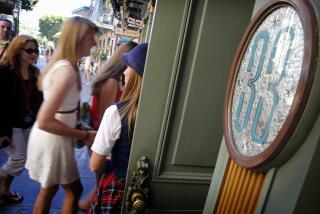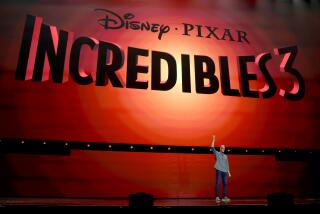Company Town : Disney Skull Session: Button Your Lip
Last week, Walt Disney Co. head honcho Michael Eisner made a rare appearance at the studio’s weekly motion picture group meeting. This particular meeting, called and run by movie chief Joe Roth, was rare in and of itself since it was the first time executives from all three Disney film labels--Disney Pictures, Touchstone Pictures and Hollywood Pictures--were called together collectively.
Normally, the heads and staffs of each of the creative groups meet separately with the studio chief to discuss their respective unit’s current movie projects. At the top of the luncheon meeting, Roth ordered the roomful of 21 executives to keep the contents of the session strictly confidential. He wanted to know that he was operating in a “safe” environment in which he and everyone in the room could feel comfortable discussing internal business without the threat of any information leaking to the press.
So much for loyalty.
Roth’s emphatic plea to remain tight-lipped (or else!) and Eisner’s conspicuous presence at the meeting--which undoubtedly created anxiety among the executives who were asked to talk about their two favorite projects of the moment--had a sort of chilling effect on the room. “The air was so thick you could cut it with a knife,” said one source.
In fact, when queried about what might be the significance of Eisner’s appearance at the meeting, two different executives actually insisted to The Times that the CEO wasn’t even there. The more guilt-ridden of the two called the next day to apologize for lying. “You don’t understand the unbelievable recriminations we get for talking to the press,” said the insider, noting how the phone logs were checked to try to ferret out the culprit.
More importantly, what exactly was Eisner doing at the meeting? And why was Roth insisting that all his production executives be herded together?
As Roth explained to the group, the purpose of the meeting was twofold: to bring Eisner up to speed on who the executives were and what movie projects and talent they were pursuing, and to “knock down the walls” of communication between the three divisions, which he felt had become much too competitive with each other for the company’s own good.
Roth says he will continue to hold the individual weekly “work sessions” with each of the division heads and their staffs to review projects and new ideas, but plans to add the weekly or bimonthly “communal” meeting of all three labels.
“I’m trying to get people to stop obsessing about what the other guy is doing,” says Roth. “When you set up units to foster internal competition like these have been, the process is more insular. You get further away from the guy buying the ticket (at the box office) in Burbank, or wherever, and more concerned about what the guy down the hall from you is doing. It’s very destructive.”
*
Some Disney insiders speculate that Eisner’s newly felt presence may be a signal that the tall guy wants to be more hands-on involved with the live-action movie side of the company, which he has openly and publicly admitted has been a creative and financial embarrassment for years. Only recently, with the release of last holiday season’s mega-hit “The Santa Clause,” the Tim Allen comedy that has grossed $143 million, have Disney’s live-action movies shown any signs of real vital life.
Long before Roth’s arrival at the studio five months ago, Eisner had apparently been feeling virtually shut out of the live-action loop (well, he did have a few minor distractions like EuroDisney). Up until a few years ago, he regularly attended the creative meetings, and now he wants back in.
“He doesn’t want to feel like a f------ stranger in his own company!” as one Disney insider put it.
Sources say Eisner feels particularly out of touch since there’s been a major reorganization of the divisions and executive reshuffling under Roth following the forced departure of his predecessor Jeffrey Katzenberg last fall.
But Eisner insists that he has no intention of getting directly involved (“I’m not going to be dealing with talent or reading scripts”) and will not try to second-guess Roth or undermine his authority to make the pictures he wants to make.
“The solution to our live action (problems) is Joe Roth, not me,” says Eisner. “Joe is the captain of the team, and I’m somewhere on the bench at his disposal. I’m a good asset for him to use.”
Roth--a maverick who likes to run his own show--says that not only does he not feel threatened by Eisner’s renewed interest in the movie end, he’s the one who’s invited his boss to participate.
“For a CEO of a company not to be familiar with the people who are generating the ideas and with what the ideas for movies are, frankly puts too much pressure on me,” says Roth, adding, “It seems to me that he who comes from the movie business, like Michael, should get involved.”
Besides, Eisner admits he misses all the movie gossip.
“The creative gossip--in the sense of who’s made a good movie or who’s doing dramas--is always interesting and healthy to keep one’s juices alive. It’s fun to listen to a bunch of executives talk about movie ideas.”
Especially if those ideas translate into dollars. Right, Mikey?
More to Read
The biggest entertainment stories
Get our big stories about Hollywood, film, television, music, arts, culture and more right in your inbox as soon as they publish.
You may occasionally receive promotional content from the Los Angeles Times.










